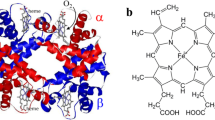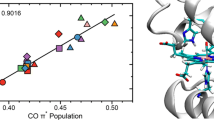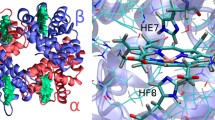Abstract
Most biological substrates have distinctive sizes, shapes, and charge distributions which can be recognized specifically by proteins. In contrast, myoglobin must discriminate between the diatomic gases O2, CO, and NO which are apolar and virtually the same size. Selectivity occurs at the level of the covalent Fe-ligand complexes, which exhibit markedly different bond strengths and electrostatic properties. By pulling a water molecule into the distal pocket, His64(E7)1 inhibits the binding of all three ligands by a factor of ∼10 compared to that observed for protoheme-imidazole complexes in organic solvents. In the case of O2 binding, this unfavorable effect is overcome by the formation of a strong hydrogen bond between His64(E7) and the highly polar FeO2 complex. This favorable electrostatic interaction stabilizes the bound O2 by a factor of ∼1000, and the net result is a 100-fold increase in overall affinity compared to model hemes or mutants with an apolar residue at position 64. Electrostatic interaction between FeCO and His64 is very weak, resulting in only a two- to three-fold stabilization of the bound state. In this case, the inhibitory effect of distal pocket water dominates, and a net fivefold reduction in K CO is observed for the wild-type protein compared to mutants with an apolar residue at position 64. Bound NO is stabilized ∼tenfold by hydrogen bonding to His64. This favorable interaction with FeNO exactly compensates for the tenfold inhibition due to the presence of distal pocket water, and the net result is little change in K NO when the distal histidine is replaced with apolar residues. Thus, it is the polarity of His64 which allows discrimination between the diatomic gases. Direct steric hindrance by this residue plays a minor role as judged by: (1) the independence of K O2, K CO, and K NO on the size of apolar residues inserted at position 64, and (2) the observation of small decreases, not increases, in CO affinity when the mobility of the His64 side chain is increased. Val68(E11) does appear to hinder selectively the binding of CO. However, the extent is no more than a factor of 2–5, and much smaller than electrostatic stabilization of bound O2 by the distal histidine.
Similar content being viewed by others
Author information
Authors and Affiliations
Additional information
Received, accepted: 23 May 1997
Rights and permissions
About this article
Cite this article
Olson, J., Phillips Jr., G. Myoglobin discriminates between O2, NO, and CO by electrostatic interactions with the bound ligand. JBIC 2, 544–552 (1997). https://doi.org/10.1007/s007750050169
Issue Date:
DOI: https://doi.org/10.1007/s007750050169




